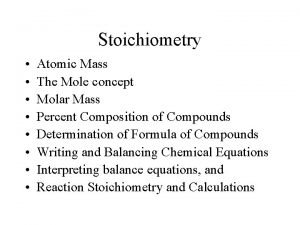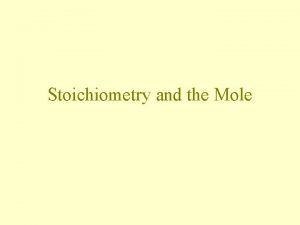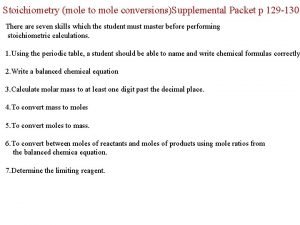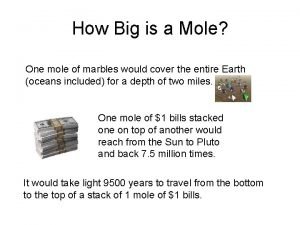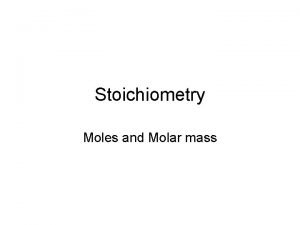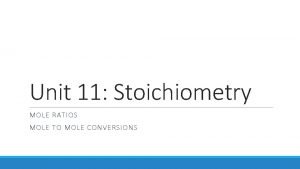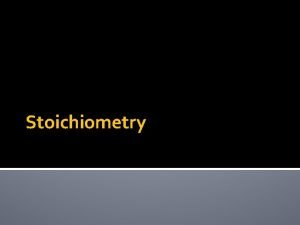Stoichiometry mole to mole conversionsSupplemental Packet p 129







- Slides: 7

Stoichiometry (mole to mole conversions)Supplemental Packet p 129 -130 There are seven skills which the student must master before performing stoichiometric calculations. 1. Using the periodic table, a student should be able to name and write chemical formulas correctly 2. Write a balanced chemical equation 3. Calculate molar mass to at least one digit past the decimal place. 4. To convert mass to moles 5. To convert moles to mass. 6. To convert between moles of reactants and moles of products using mole ratios from the balanced chemica equation. 7. Determine the limiting reagent.

Stoichiometry supplemental packet page 129 3. Calculate molar mass and place each molar mass underneath 1. each Translate word problem into a reaction of reactants and products. reactant or product. 2. Write out athe balanced reaction: CH 444 (g) 11 CH CH (g) 16. 0 O 222 (g) ---------> 22 H H 222 O O (l) +++ 22 O O (g) -----> H O (l) 32. 0 18. 0 +++ CO 222 (g) 11 CO CO (g) 44. 0

Stoichiometry supplemental packet page 129 4. From the equation, the given masses of starting Methane gas original is burned in excessplace oxygen to produce carbon dioxide & wate materials the corresponding reagent and ais produced? If 25. 0 gramsorofproducts methaneabove is burned how many grams of water question the mark for the information you are seeking. 1. balance reaction The term excess means you have enough reagent for complete reaction. 2. calculate molar mass grams 25. 0 excess ? ? 1 CH 4 (g) + 2 O 2 (g) -----> 2 H 2 O (l) + 1 CO 2 (g) MM (g/mole) 16. 0 32. 0 18. 0 44. 0 moles 1. 56 excess ? ? 3. make a table grams A 2 --->2 A (balanced reaction ) MM moles 4. complete the table

Stoichiometry supplemental packet page 130 6. From the original equation, place the given masses of starting materials or products above the corresponding reagent and a question mark for the information you are seeking. The term excess means you have enough reagent for complete reaction. Complete the table by first calculating moles H 2 O and moles CO 2 grams 25. 0 excess ? ? 1 CH 4 (g) + 2 O 2 (g) -----> 2 H 2 O (l) + 1 CO 2 (g) MM (g/mole) 16. 0 32. 0 18. 0 44. 0 moles 1. 56 excess moles H 2 O? moles CO 2? moles 1. 56 moles CH 4 x 2 moles H 2 O 1 mole CH 4 = 3. 125 moles H 2 O moles 1. 56 moles CH 4 x 1 moles CO 2 1 mole CH 4 = 1. 56 moles CO 2

Stoichiometry supplemental packet page 130 7. From the original equation, place the given masses of starting materials or products above the corresponding reagent and a question mark for the information you are seeking. The term excess means you have enough reagent for complete reaction. Using the moles H 2 O and moles CO 2 , calculate grams of H 2 O and CO 2 grams 25. 0 excess ? ? 1 CH 4 (g) + 2 O 2 (g) -----> 2 H 2 O (l) + 1 CO 2 (g) MM (g/mole) 16. 0 32. 0 18. 0 44. 0 moles 1. 56 excess 3. 125 1. 56 moles CH 4 x 2 moles H 2 O 1 mole CH 4 = 3. 125 moles H 2 O moles 1. 56 moles CH 4 x 1 moles CO 2 1 mole CH 4 = 1. 56 moles CO 2

Stoichiometry supplemental packet page 130 7. From the original equation, place the given masses of starting materials or products above the corresponding reagent and a question mark for the information you are seeking. The term excess means you have enough reagent for complete reaction. grams 25. 0 1 CH 4 (g) MM (g/mole) 16. 0 moles 1. 56 excess grams H 2 O grams CO 2 + 2 O 2 (g) -----> 2 H 2 O (l) + 1 CO 2 (g) 32. 0 18. 0 44. 0 excess 3. 125 1. 56 moles 3. 125 moles H 2 O x 18. 0 grams H 2 O 1 mole H 2 O = 52. 6 grams H 2 O moles 1. 56 moles CO 2 x 44. 0 grams CO 2 1 mole CO 2 = 68. 6 grams CO 2

Stoichiometry supplemental packet page 129 4. From the original equation, place the given masses of starting materials or products above the corresponding reagent and a question mark for the information you are seeking. The term excess means you have enough reagent for complete reaction. And Your Done!!!!! grams 25. 0 excess 56. 2 68. 6 1 CH 4 (g) + 2 O 2 (g) -----> 2 H 2 O (l) + 1 CO 2 (g) MM (g/mole) 16. 0 32. 0 18. 0 44. 0 moles 1. 56 excess 3. 125 1. 56 moles 3. 125 moles H 2 O x 18. 0 grams H 2 O 1 mole H 2 O = 56. 2 grams H 2 O moles 1. 56 moles CO 2 x 44. 0 grams CO 2 1 mole CO 2 = 68. 6 grams CO 2


